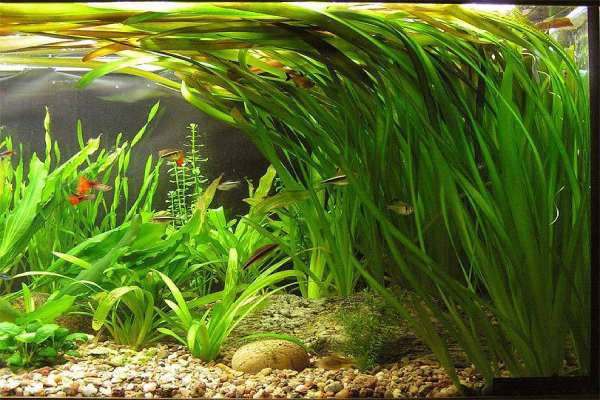Orange Koi Fish – Koi With Orange Markings [Pictures]
The vibrant orange color of most koi fish is more than simply a lovely sight; it is believed to represent passion, warmth, strength, and good luck.
But, have you ever wondered if this is true? You know, a lot of people think that particular koi fish such as orange koi act as small luck charms in the water.
It’s also believed that the bright orange of their scales reflects the warmth and vigor of summer, and it is said to bring happiness and cheer. These beliefs are frequently associated with hope and renewal in Shinto beliefs.
Well, if you are a hobbyist who is looking for orange koi to add to your aquarium probably because of this belief or you just want that vibrant orange color in your aquarium then keep scrolling because we’ve got you covered.
In a minute, we will discuss the different types of koi fish with orange markings that you can add to your aquarium but first, let’s get to know more about this lovely fish.
![Orange Koi Fish - Koi With Orange Markings [Pictures]](https://aquifacts.com/wp-content/uploads/2024/03/orange-koi-fish_1.jpg)
What is a Koi Fish?
Koi fish are colorful fish that are commonly kept in ponds or aquariums. They come in a variety of colors, including red, orange, yellow, blue, and black.
Koi fish are recognized for their stunning patterns, which can include spots, stripes, and even patches of different colors.
Do Koi Fish Bring Good Luck?
First, it’s worth noting that the concept of koi fish bringing “good luck” is firmly ingrained in Japanese culture and tradition.
Koi with specific colors and patterns are said to represent positive attributes such as happiness, riches, and long life. These beliefs are based on Shinto, Japan’s native religion.
For instance, orange koi, commonly known as Kohaku, is arguably the most popular type of good luck koi. In Shinto culture, orange represents the sun and fire and is thought to bring pleasure and wealth.
This concept is represented in the word “Kohaku,” which means “orange and white.” In addition to their color, Kohaku is noted for their graceful and beautiful motions, which contribute to their attraction.
Some people believe that having an orange koi in a pond or lake can bring them good luck. It is also believed that looking into a Kohaku koi’s eyes will bring good fortune.
Orange koi are also thought to represent tenacity and perseverance, making them appealing to those looking for strength and motivation.
Types of Orange Koi Fish
There are lots of orange koi fish available and we will discuss the popular ones that you can add to your aquarium in this section. Below are the different types of orange Koi:
Hikari Muji
Hikari Muji koi, often known as “Shiro Muji,” are among the most attractive types of orange koi.
They were first bred in Japan and gradually gained popularity outside of Japan and are today seen in ponds all over the world.
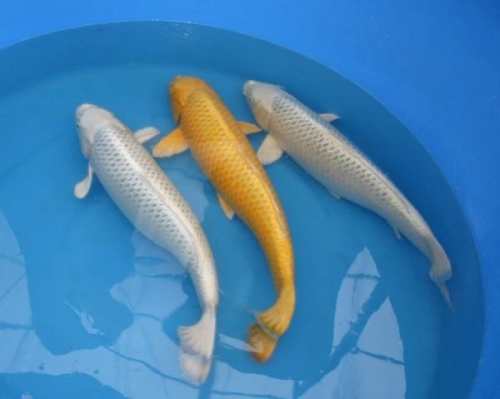
They are in complete plain color, with no markings. Their shiny color adds beauty to your aquarium.
They are well-known for being quite hardy and easy to care for, making them popular among newbie koi keepers.
Taisho Sanshoku
Taisho Sanshoku koi, often known as “Sanke,” are also among the most popular types of orange koi. They are easily identified by their black, red, and white appearance. The red color mostly appears bright orange.

The term “Taisho Sanshoku” refers to the Taisho Era in Japan, during which these koi were initially bred. Today, Sanke koi are noted for their exquisite beauty and are frequently kept by a lot of hobbyists.
They can be quite expensive, as the right combination of coloration is hard to come by. However, Sanke koi are thought to bring good fortune to their owners. In fact, they are often known as the “lucky koi.”
Tancho
Tancho koi are one of the most unique and sought-after types of orange koi. They are easily distinguished by the vivid red-orange spot on their heads, which is supposed to mimic the crest of a Tancho (or Japanese red-crowned crane).

Tancho koi are extremely rare, with only around one in every 10,000 koi. They are valued for their distinct appearance and are seen as a symbol of good luck and fortune just like Taisho Sanshoku koi,
You can keep them in your indoor tanks where they may be seen and appreciated. However, you will have to give them more attention since their head area is particularly vulnerable to harm.
Additionally, Tancho koi can live long and healthy lives if you give them proper conditions.
Kohaku
Kohaku is one of the most popular and recognizable types of koi fish. They are distinguished by their beautiful white bodies with intense orange-red markings, or “hi.”
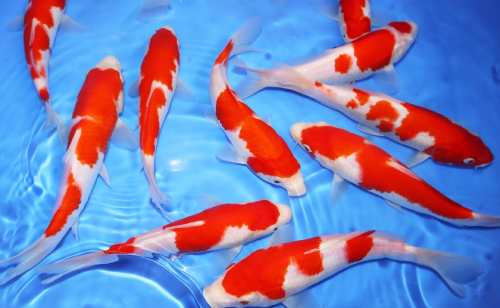
Kohaku koi is one of the earliest types of koi, going back to the Edo era in Japan (1603-1868). They were first bred in Niigata, Japan, which is still regarded as the core of koi today.
Kohaku koi are referred to as the “King of Nishikigoi,” or decorative carp. This is due to their breathtaking look. If you’re interested in breeding Kohakukoi, there are two main types you can consider and they are;
- The white with red and orange pattern.
- The red variety with a yellow nose, and the white.
While the latter is the more sought-after variety, it can be more difficult to maintain due to the complexity of the color and its diversity adds to the allure of these unique fish.
Asagi koi
The Asagi koi is one of the earliest types of koi fish, going back to Japan’s Edo period (1600-1867).
Asagi koi are recognized for the vibrant blue net-like designs on their body. They have orange marks on their head, belly, tails, and fins.

Asagi koi are frequently regarded as a more difficult species of koi to care for, as they are sensitive to water quality and susceptible to certain infections.
However, experienced koi keepers value them for their distinct beauty and rarity.
Koromo koi
The Koromo koi, commonly known as “Shibori” or “striped” koi, is a type of koi named after its unusual striped appearance.
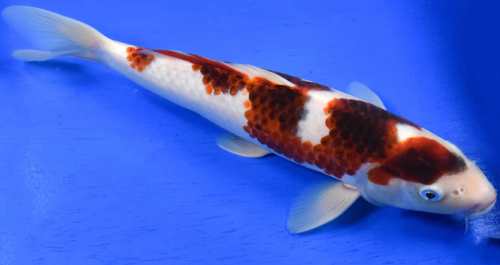
The design is formed by a unique gene that gives the koi’s res and a white metallic sheen. This results in a beautiful, striped pattern that looks like that of Asagi.
Koromo koi are noted for their hardiness, making them a popular choice among both seasoned and rookie koi keepers.
Utsuri koi
Utsuri koi are another famous koi fish, distinguished by their stunning black-and-orange appearance. The name “Utsuri” means “reflection” in Japanese, and refers to the fish’s mirror-like appearance.
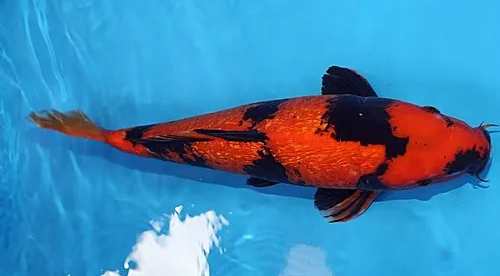
Utsuri koi have a predominantly black body with white patterns that appear on their tail and fins. Shiro Utsuri koi have white scales on their black bodies, while Hi Utsuri has black scales on their white body. There are also Aka Utsuri (red and white) and Ki Utsuri (yellow and white).
Utsuri koi are assumed to be a mutation of Kohaku koi that originated in the Hiroshima region of Japan. Like Kohaku koi, Utsuri koi are fairly expensive, with top-quality fish costing thousands of dollars.
Hariwake koi
The Hariwake koi is a lovely koi fish with brilliant orange and yellow colors. The Hariwake koi has a long and fascinating history, dating back to Japan in the 1800s.
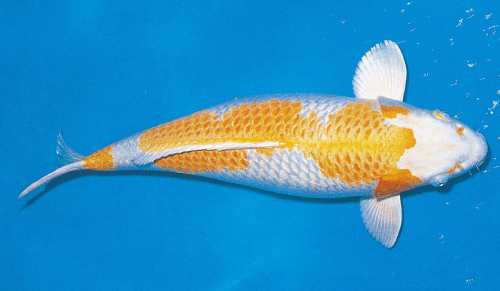
The original Hariwake koi were developed by Japanese breeders who crossed orange and yellow koi to create this distinct species.
It immediately became a popular fish among koi fans, admired for its beauty. The Hariwake koi species has grown in popularity over the years.
Hariwake has a spherical, pear-shaped body and a gently curved head, giving it a traditional koi appearance. Its scales glitter in the water, reflecting light while it swims adding beauty to your aquarium.
The Hariwake’s personality is equally stunning as its appearance. It is a stately fish, calm and controlled, but playful.
Bekko
Bekko koi come in a variety of colors and patterns. The most common type is the Shiro Bekko, which has a white body with black patterns. The Aka Bekko is a less frequent type with a red-orange body and black or white patterns.

Aka Bekko, unlike other types of koi, has no facial markings. This distinguishes them from other types of orange koi.
Their distinctive colors and absence of facial marks give them an intriguing and eye-catching. Whether you choose a Shiro Bekko or an Aka Bekko, you will add a magnificent and unique fish to your aquarium.
Conclusion
Orange koi fish are more than just vibrant aquatic creatures. Their presence is symbolic of strength, perseverance, and a connection to Japanese culture and tradition.
From the bright and bold Kohaku to the graceful Bekko koi, there is a wide variety of orange koi fish for you to choose from.
With their distinct patterns, unique personalities, and varied histories, each type of orange koi fish offers its unique appeal.
Whether you’re drawn to regal Kohaku or the playful and friendly Shiro Utsuri, there is a type of koi fish for everyone.
Remember, no matter how many orange koi you have, they can bring you a sense of inner strength, according to Japanese culture.
Read Also: 7 Types of Koi Pond Tanks [Koi Fish Habitat]
FAQs
Different markings can represent a variety of concepts, including strength, courage, and perseverance. Some people believe that the markings on koi fish represent overcoming challenges, making them a sign of good fortune.
An all-orange koi fish is called “Hikari Muji koi” often known as “Shiro Muji,”. They are among the most attractive types of orange koi. This variety of koi is well-known for its brilliant and pure orange color.
Many people believe that a red or orange koi fish will bring them good luck. In traditional Japanese culture, the color red represents good fortune and success. As a result, keeping a red or orange koi in your pond or aquarium is said to provide positive energy and luck.
The value of a koi fish is determined by a variety of variables, including its color, pattern, and general beauty. The most desirable koi are frequently those with an ideal color combination and a well-defined pattern. In general, brilliant and distinct colors increase a koi’s value, with some collectors prepared to pay a premium for a particularly magnificent species.

![White Koi Fish [Japanese Koi Fish Varieties]](https://aquifacts.com/wp-content/uploads/2024/03/white-koi-fish_img.jpg)

![Koi Fish Tail Anatomy [Exploring Koi Fins & Tail]](https://aquifacts.com/wp-content/uploads/2024/03/koi-fish-tail-anatomy_img.jpg)

